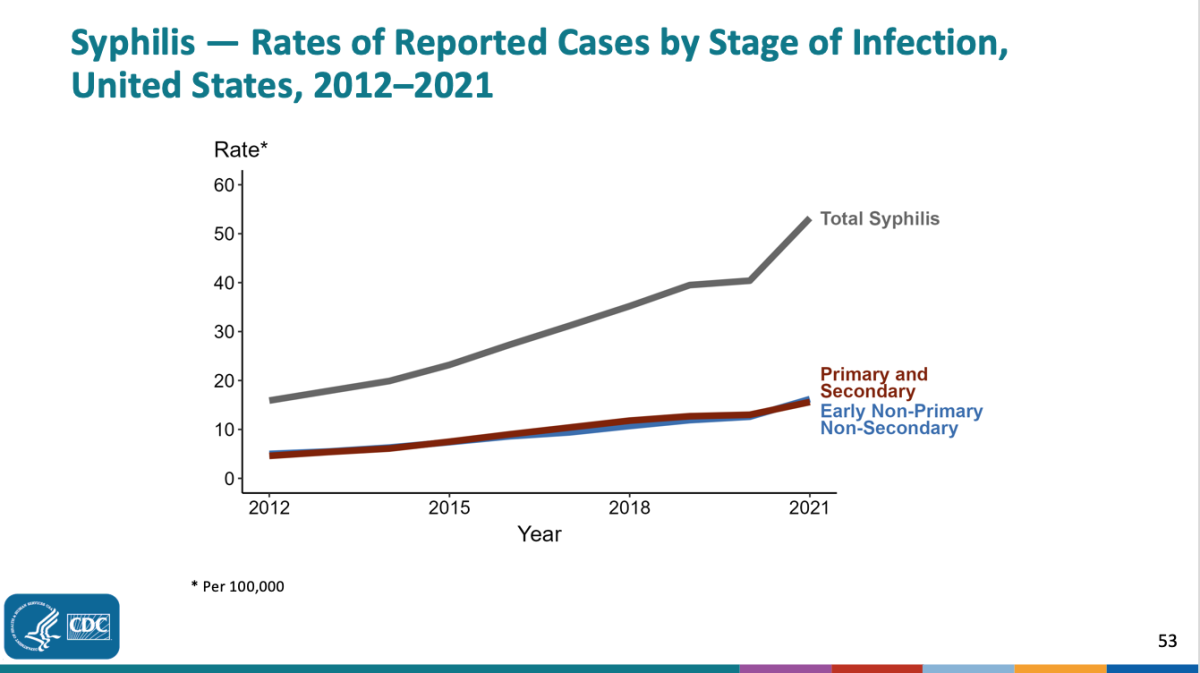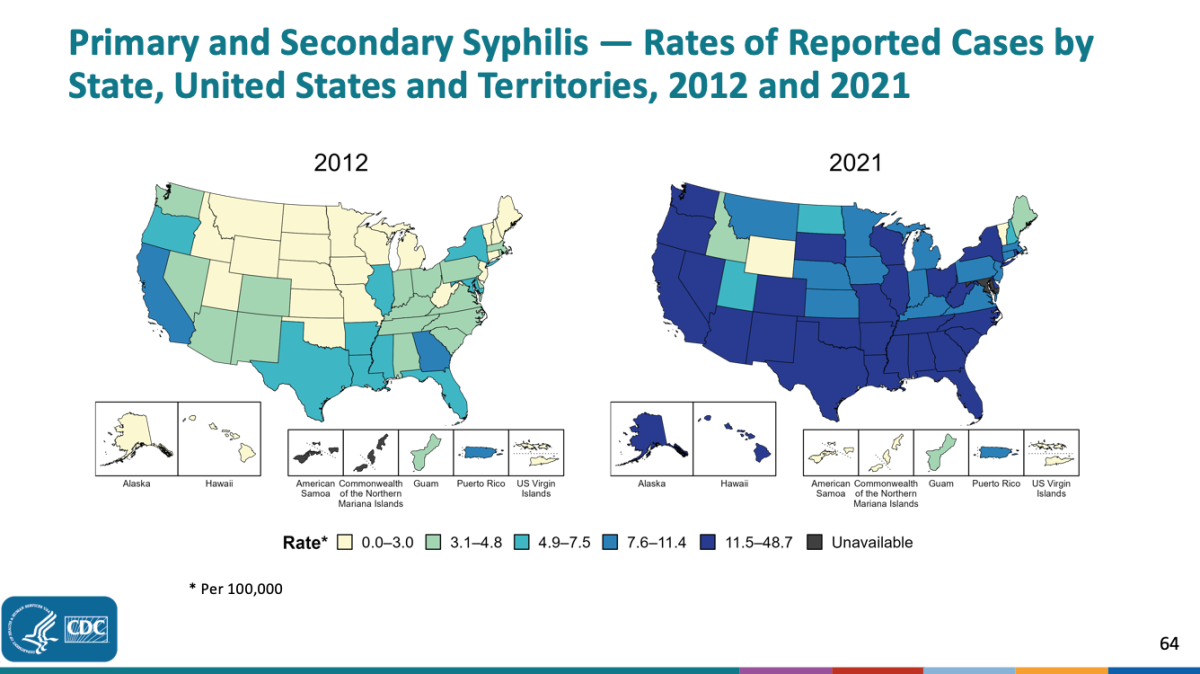Rates of the sexually transmitted infection (STI) syphilis are on the rise, having climbed significantly in the two decades since the early 2000s.
According to a report released by the Centers for Disease Control and Prevention (CDC) on April 11, syphilis is now recorded at rates not seen since the 1950s, and it increased by around 30 percent between 2020 and 2021 alone.
The CDC data shows that in 2020, there were 134,000 cases of syphilis reported in the U.S., which increased to 176,000 cases in 2021. This is a huge jump from the rates of syphilis that were recorded in the early 2000s, where only around 30,000 cases each year were recorded.

Syphilis is an infection by a subspecies of the bacterium Treponema pallidum, usually transmitted from person to person via vaginal, anal, or oral sex.
"Syphilis infections are often asymptomatic and also the symptoms mirror many other common conditions, and therefore it can go undiagnosed until it has serious effects. Without treatment, people can spread it to others," Sarah Steele, a senior research associate in Cambridge Public Health at the University of Cambridge, told Newsweek.
"Indeed, the symptoms of syphilis may not be immediately obvious to many, and for those who are symptomatic, symptoms may disappear for a time or mimic other common diseases, leading to misdiagnosis or treatment delay."
Syphilis will usually develop in several stages, known as the primary, secondary, latent, and tertiary stages, with each stage having different symptoms. The first to appear are usually chancres, or small, painless sores or ulcers, often in or around the genitals, or in the mouth that develop between two and six weeks after exposure. In the subsequent stages, a blotchy red rash may appear, often on hands or feet, as well as small skin growths, white patches in the mouth, fatigue, headaches, joint pain, fever and swollen glands.

Some people don't experience any symptoms at all, while in others, they resolve by themselves after a short time and the disease then moves into its latent stage, where there also may be no symptoms at all.
"[The latent stage] may last for several years before eventually developing into tertiary syphilis, the most devastating stage that can cause substantial damage to a number of organs, including the heart, eyes, brain and wider nervous system," Simon Bishop, an associate professor of medicine at Anglia Ruskin University in the U.K., told Newsweek. "It's also possible for mothers to transmit the disease to their unborn children, leading to a condition called congenital syphilis that is associated with often quite severe disfigurement caused by bone deformity, as well as a number of other health issues."
The CDC report also found that there was an over 30 percent rise in congenital syphilis between 2020 and 2021.
Congenital syphilis has increased 203% since 2017. In 2021, 46 states reported at least one case of syphilis among babies in 2021. Congenital syphilis-related stillbirths and infant deaths increased to 220 in 2021. #STDreport #STIweek pic.twitter.com/q94AOXZAi1
— CDC STD (@CDCSTD) April 11, 2023
"If left untreated for years, syphilis can affect the brain or other parts of the body, causing serious long-term problems," Steele said.
This rise in cases seen in the data is likely due to the effects of COVID on the healthcare system and symptoms being missed, as well as changes in the way that people have sex.
"Changes in rates of STIs are attributable in part to behavior changes, especially in higher risk groups, but also the declines in screening participation during the pandemic, alongside the closure of some services due to lack of staff and funding," Steele said. "The redeployment of many people and resources during COVID decimated many services."
It may also be due to a combination of a number of other factors, including the fact that it is often undiagnosed or dismissed as a common cold or flu, and therefore accidentally spread to others.
Bishop suggests that another driver may be a reduction in condom use, both in heterosexual and MSM (men who have sex with men) sexual relationships.
"This in itself has been driven by the advent of PrEP (pre-exposure prophylaxis) drugs that protect against HIV without the need to use condoms, as well as a general population-wide reduction in the fear of HIV infection," Bishop said.

"A general increase in casual sex within some populations, in part driven by apps such as Tinder and Grindr – the more people that one has unprotected sex with, the greater the risk. In recent years the public health focus has been on chlamydia, primarily because it's more widespread as an STI and easier to diagnose," he said. "As a result, syphilis has been a little neglected – it's still tested for in blood-based sexual health screenings and routinely in pregnant women etc, but doesn't hold the same place in the public's consciousness as some other infections."
The CDC report also found that the 2021 rates of chlamydia and gonorrhea far outpaced those for syphilis, with over 1.6 million cases of chlamydia reported in 2021, and over 700,000 cases of gonorrhea. The figures marked a 4 percent increase in chlamydia from the 2020 numbers, and a 4.6 percent rise in gonorrhea.
"In terms of [syphilis's] relative severity compared to other STIs, although diseases such as chlamydia, gonorrhea and herpes can cause some unpleasant symptoms, and HPV and hepatitis B/C can lead to cancers (typically cervical/oral and liver respectively), none of these have the same combination of ease of transmission and multi-organ involvement as untreated syphilis," Bishop said.
This rise in cases isn't disastrous, as the disease can be treated with antibiotics. As with many bacterial infections, however, syphilis has begun to develop some degree of resistance to many drugs.
"Although syphilis can be easily treated with antibiotics (usually benzathine penicillin G) there is some evidence for the emergence of drug resistance," Bishop said. "If this happens, the disease risks becoming much more difficult to treat, making its prevention and early diagnosis even more important."
Steele stresses that while these increases in cases may seem large, syphilis is still contracted in much lower numbers than many other STIs, including chlamydia and gonorrhea.
"It's also important to remember syphilis remains low in terms of absolute numbers, so a small increase expressed as a percentage can seem much more significant an increase than other STIs," she said.
Do you have a tip on a science story that Newsweek should be covering? Do you have a question about syphilis? Let us know via science@newsweek.com.
Uncommon Knowledge
Newsweek is committed to challenging conventional wisdom and finding connections in the search for common ground.
Newsweek is committed to challenging conventional wisdom and finding connections in the search for common ground.
About the writer
Jess Thomson is a Newsweek Science Reporter based in London UK. Her focus is reporting on science, technology and healthcare. ... Read more
To read how Newsweek uses AI as a newsroom tool, Click here.





